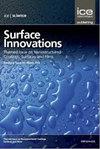Slippery surface with ternary coupled structures for improving lubricant storage capacity
IF 3.5
4区 材料科学
Q3 CHEMISTRY, PHYSICAL
引用次数: 0
Abstract
A slippery surface has the capability to protect the substrate surface, which can prevent substrate corrosion in a harsh environment. However, existing slippery surfaces have the limitation of insufficient oil-locking capability for rough structures, which limits their practical application. To solve the aforementioned limitation, the authors developed a slippery surface with a good oil-locking capability. First, a wire-cutting machine tool was used to fabricate ternary coupled grooved structures on an aluminum (Al) substrate, which could increase the lubricant-storage capacity of the microstructures, and the substrate was named slippery porous surface with groove-textured aluminum (Slips-G-Al). Then, a surface durability test was performed involving lubricant shear, sandpaper wear and water impact. The chemical stability test involved acid, alkali, salt corrosion and weather resistance tests, which showed that Slips-G-Al had a good lubricant-storage capacity compared with the traditional Slips surface. In addition, the self-cleaning performance and the fog collection capability of Slips-G-Al were also studied. Finally, an electrochemical corrosion test of Slips-G-Al was carried out. The findings showed remarkable application prospects in the aerospace and shipbuilding fields.光滑表面三元耦合结构,提高润滑油储存能力
光滑的表面具有保护基材表面的能力,可以防止基材在恶劣环境中被腐蚀。然而,现有光滑表面对粗糙结构的锁油能力不足,限制了其实际应用。为了解决上述限制,作者开发了一种具有良好锁油能力的光滑表面。首先,利用线切割机床在铝(Al)基板上制备三元耦合沟槽结构,增加了微观结构的润滑油储存能力,并将基片命名为带有沟槽织构铝的光滑多孔表面(slip - g -Al)。然后,进行了包括润滑油剪切、砂纸磨损和水冲击在内的表面耐久性测试。化学稳定性测试包括酸、碱、盐腐蚀和耐候性测试,表明与传统的slip表面相比,slip - g - al具有良好的润滑油储存能力。此外,还研究了slip - g - al的自清洁性能和集雾能力。最后,对滑模- g - al进行了电化学腐蚀试验。研究结果在航空航天、造船等领域具有良好的应用前景。
本文章由计算机程序翻译,如有差异,请以英文原文为准。
求助全文
约1分钟内获得全文
求助全文
来源期刊

Surface Innovations
CHEMISTRY, PHYSICALMATERIALS SCIENCE, COAT-MATERIALS SCIENCE, COATINGS & FILMS
CiteScore
5.80
自引率
22.90%
发文量
66
期刊介绍:
The material innovations on surfaces, combined with understanding and manipulation of physics and chemistry of functional surfaces and coatings, have exploded in the past decade at an incredibly rapid pace.
Superhydrophobicity, superhydrophlicity, self-cleaning, self-healing, anti-fouling, anti-bacterial, etc., have become important fundamental topics of surface science research community driven by curiosity of physics, chemistry, and biology of interaction phenomenon at surfaces and their enormous potential in practical applications. Materials having controlled-functionality surfaces and coatings are important to the manufacturing of new products for environmental control, liquid manipulation, nanotechnological advances, biomedical engineering, pharmacy, biotechnology, and many others, and are part of the most promising technological innovations of the twenty-first century.
 求助内容:
求助内容: 应助结果提醒方式:
应助结果提醒方式:


